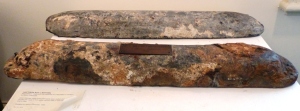Object number
93.3:1-2 Lead ingot. One of several found from “L’Astrolabe” at Vanikoro by Reece Discombe.
These would have been used for melting down to make lead shot or balls for the weaponry. Several similar ingots were found on “La Boussole”. On the flat side is the letter “A”. Ingots found on “La Boussole” had the same letter “A” on them. There are also three marks evident on the flat side forming a stamp from when the ingots were cast.
Measurements
93.3.1 L:885 W:155 D:82 mm
93.3.2 L:885 W:170 D:70 mm
Place Made: Brest, France
Reece Discombe states:
When I located the Boussole, I found several similar ingots. The lead ingot was possibly used to make musket balls. Weight is 83 kilos. Plenty of these were found on each wreck site. Each lead ingot had various markings. The letter A we thought meant Astrolabe but this was not so. The other mark which was the manufacturers mark can be seen. This we traced back to the makers in Brest.
I then thought that it was the same ship as the Astrolabe, that had broken in half and drifted along the outside of the reef before finally sinking. So uncertainty was still in my mind if in fact this was the Boussole. When the two vessels left Brest, each carried approximately 16 anchors each.
RELICS RECOVERED BY REECE DISCOMBE FROM THE “ASTROLABE” DONATED TO THE LAPEROUSE MUSEUM
After one hundred and seventy years in a watery grave on the ocean floor, the long awaited artefacts from the “Astrolabe” are presently on display in the Laperouse Museum. These evocative pieces were discovered by Reece Discombe, a New Zealand diver and expert in underwater salvage who, fascinated by the mystery of Laperouse started diving on the reefs of Vanikoro. Mr Discombe’s skill and persistence led to their discovery in 1958, on the reefs, beneath one metre of coral. The artefacts serve as a poignant reminder of the untimely and tragic ending to the three year voyage of Jean Francois de Galaup, Comte de Laperouse and the crew of the “Astrolabe” and the”Boussole
Reece Discombe and his discoveries
Reece Discombe was born in New Zealand, and acquired a well- developed sense of the geographical presence of the neighbouring South Pacific islands from an early age. Russell Shelton, the author of “From Hudson Bay to Botany Bay” explains why Discombe was the perfect man to be involved in the discovery: “an affinity for salt water, his physical power and swimming ability, coupled with a natural mechanical aptitude with motors and metals… prepared him well for his involvement in the saga of Laperouse.”
His interest in salvage diving led Discombe to the New Hebrides in 1947. The largest island “Espiritu Santo” had an enormous war surplus dump which Discombe astutely realised could be used to supply the marketplace that had been starved for six years of newly manufactured machinery. For fourteen years, he carried out salvage dives on wrecks around the New Hebrides. He jokingly describes himself “as having spent half of his life underwater”. Discombe had read much of the material available about Laperouse. His curiosity resulted in the establishment of an expedition party in 1958. The party left Vila for Vanikoro on the sixty foot launch, the “Don Quixote”. From this trip, which was to be the first of many made between 1958 and 1964, Discombe and his companions found many treasures including cast iron ballast blocks, lead ingots, brass wheels, canons, iron rods, kegs of nails, buttons, hundreds of glass pieces, fragments of white porcelain and a number of anchors. Discombe returned with teams of divers to the “Astrolabe” site many times to explore this underwater archaeological site. In 1964, Discombe’s crowning glory was the discovery and exploration of Laperouse’s flagship, the “Boussole”. This resulted in the launch of three French sponsored expeditions to confirm the existence of the second wreck. Reece Discombe’s perseverance in confirming the site of the “Astrolabe” and determining the location of the “Boussole” has contributed greatly to a fascinating part of maritime history. (Notes compiled by Reece Discombe and Diana New, 1993).



Pingback: Reece Discombe 100 years and 231 years of the Receveur Mass | La Perouse Museum & Headland